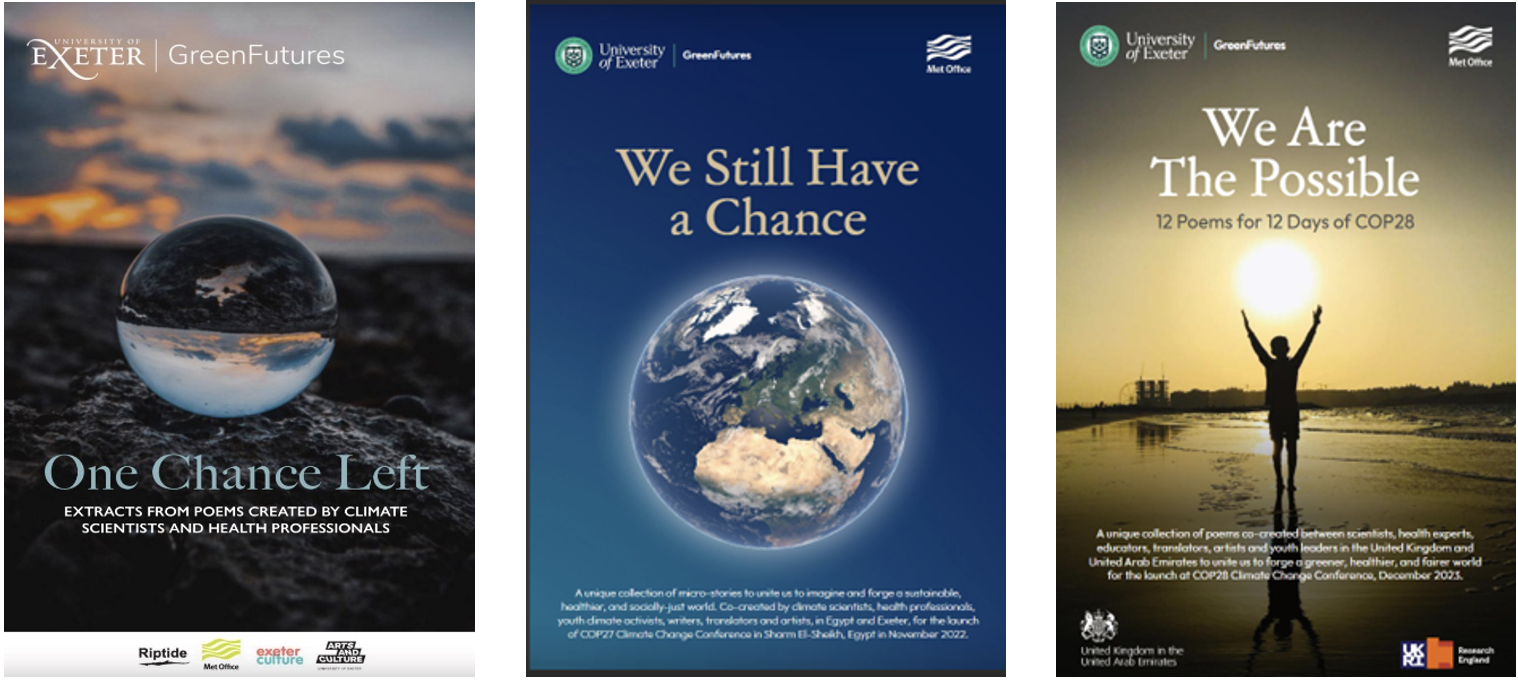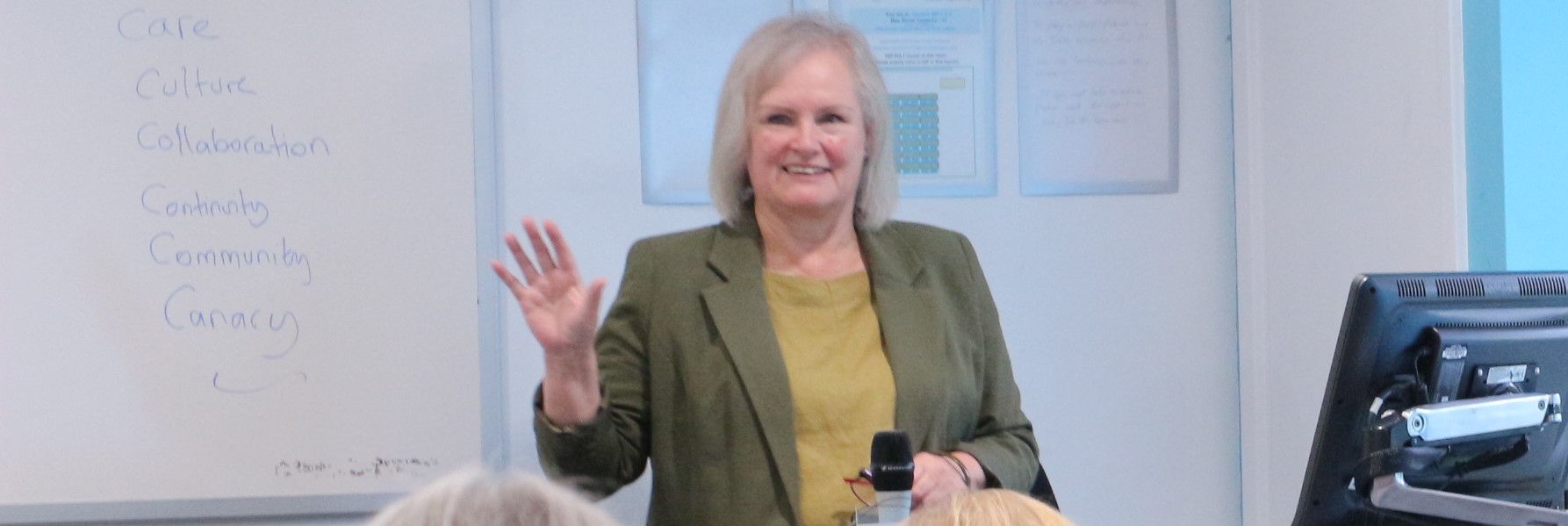
By Dr Sally Flint, Project Partner for Reading Bodies and Creative Lead for We Are the Possible
‘We need / To leap / Right now / To the next stage / Of our evolution.’
Ben Okri
Burnout, Overload, and Resilience are words that in 2024 challenge analysis in literature, healthcare, and the media, especially alongside trending headlines which can often include crisis, doomsday, disaster, pollution, guilt, greenwashing, catastrophe, apocalypse, anxiety – all used to stress the global climate emergency, and the need to urgently change the way we consume and live. It’s like being in a crammed washing machine of words on a fast spin of environmental and societal problems. A recent article shows that neurologists are ‘alarmed’: ‘Everybody has a Breaking Point’: how the climate crisis affects our brains’ (C. P. Aldern, Guardian, 2024). While writing this, the latest pop-up on my PC reads – ‘but don’t confuse burnout with being busy!’
Therefore, it was intriguing and timely to deliver a creative writing workshop where we can create a collection of writing inspired by the Reading Bodies project using Burnout, Overload and Resilience as launch pads. To do this, as a writer, editor, and creative writing lecturer working at the interface of science, health, education, translation, and the arts, I adapted a workshop and editing methodology I established to ‘share insights across languages and academic disciplines.’ At the workshop, we considered different approaches to the theme of burnout, including workplace and caring pressures, strategies for dealing with stress, and connections with individual health.
I used a unique collaborative creative writing approach developed in 2017 when working with Met Office scientists on ways to communicate climate data to the public through the arts and science. On a NERC-funded yearlong project, Climate Stories, led by renowned climate scientist Professor Peter Stott, a group of climate scientists and art practitioners shared and experimented with narrative forms. Both willing and wary, we joined in creative writing, performance, printmaking, and music workshops. As the Creative Writing Lead, I encouraged writing that ‘showed’ working in the field of climate change, and the scientists’ stories that erupted were startling, from ice cracking in the Arctic to fleeing forest fires in South America. This storytelling approach helped scientists understand how using the senses to explain data – what they could see, hear, taste, touch, and smell – brought to life what it’s really like on the frontline of climate change.
Then, as the Covid crisis spread and the world stalled, Cecilia Mañosa Nyblon (Director, We Are the Possible, University of Exeter), had an inspired vision to bring together science, health, education, translation, and the arts to communicate to broad audiences how human health relies on maintaining, restoring and protecting planetary health and ecosystems. Following a unique creative and editorial process, a collection of poems was published, and with the support of the Met Office UK, we delivered One Chance Left – 12 poems co-created by climate scientists and health professionals at an event in the first-ever Science Pavilion at the COP26 climate conference (Glasgow 2021). The poems, underpinned by science and health research, received such a positive reaction that by 2022 our team had grown to include not only scientists and health professionals, but educators, translators, youth leaders, and artists in the UK and Egypt, using a now proven creative collaborative way of working which resulted in We Still Have a Chance – 12 stories for 12 days of COP27 (Egypt 2022) which reached over 28 million people and counting.

I am increasingly emboldened and experimental in this interdisciplinary workshop design, especially when linking the UK with other countries and trusting that participants’ experiences, knowledge, and imaginations will facilitate enlightening exchanges. As we continue, especially powerful are the young people’s voices being amplified in our climate narratives.

However, collaborative writing is a complex space to enter – there are no guarantees. Lorelei Lingard writes that the main disadvantages of collaborative writing include: ‘limited coordination, the potential for chaotic development of the piece, and difficulties with version control due to simultaneity of writing. And, for more novice or less powerful writers on the team, it can produce a turbulent, threatening experience. Therefore, all-in-reaction writing works best in small, non-hierarchical groups where all members feel safe to express their opinions. When these conditions are met, it can be a powerful strategy for interdisciplinary groups to create new meanings beyond the borders of conventional disciplinary thinking.’ (National Library of Medicine.)
Editorial expertise is vital to producing an anthology which represents the voices of everyone who has contributed and taken part. It’s an intricate process, and a privilege editing the writing of others who have bravely shared their writing drafts, and recent or ongoing research. Sometimes working through and editing the collective writing is emotional given the subject matter – it needs objective eyes, and I have been lucky to work with two other highly skilled writers/editors, Dr Virginia Baily and Kim Squirrell, whose help has been invaluable in producing high-quality publications. Where possible, as editors, we try to shift narratives to a positive place. For example, the poem ‘Clouds’ in We Are the Possible anthology shows condors as in danger of extinction; as editors, we ameliorated this to reveal evidence that scientists, local communities, and indigenous groups are taking action together to save endangered species.
People ask us – why weave participants’ writing into poetry? Partly it’s because as British-Cypriot poet Anthony Anaxagorou believes: ‘Poems argue their own logic, they call on their own truth, which needn’t be an empirical one, so in this respect their reach is far more universal.’ (Theguardian.com). Poetry is a recognised form that delivers a narrative, provokes empathy, and can get a message across concisely. A truly effective and memorable poem in any language is like a bird taking off, each line reaching new heights, it challenges expectations, comes into land at a new possibility, and leaves a memory and a message, thereby rewarding the reader. Poems are where words are allowed space to live and breathe. Poetry, as Samuel Taylor Coleridge believed is, ‘the best words in the best order’. By working together poems can help translate complex research data into messages that connect with the emotions of many.
There is also a reward in reading a story or poem that can be likened to a choir harmonising, that doesn’t moralise or demand, that has erupted organically via a mutually supportive resolve to communicate climate science and health messages through the arts – and thus readers can feel part of this union too and find evidence of hope, and how to take positive action. Visual artists also generously contributed powerful visual images in support of each poem. For example, artist Luke Jerram’s ‘Giai’ appears alongside the poem, ‘Home’ (pp. 42-43).

As curator and historian Victoria Kingston writes: ‘Where science meets art and the two work together, the result can be extraordinarily productive, as horizons are broadened and gaps in our understanding of both are filled’ (Wellcomecollection.org). We hope to apply similar approaches to the Reading Bodies project, to further our understanding of individual and collective health in relation to the themes of burnout, overload, and resilience. By doing so, we will explore ideas about ways in which to address some of these challenges.
Through a ‘Reading Bodies’ specially adapted creative writing workshop, we began to explore, further understand, and release from the washing machine of words burnout and overload. We didn’t know what would happen – but something will because it’s an inspiring and innovative opportunity, to co-create a new collection of writing that will investigate how resilience is intrinsic to personal and mental health – past, present, and future.
Works Cited
Aldern, Clayton Page. ‘Everybody has a Breaking Point: How the Climate Crisis Affects our Brains’. The Guardian, 27 March 2024, https://bit.ly/4afGHKX Accessed 27 March 2024.
Anaxagorou, Anthony. ‘The Language of Politics is Shallow and Threadbare, says Poet Laureate’. The Guardian, 3 Oct 2019 Accessed 20 Feb 2024.
Kingston, Victoria. ‘The Relationship between Science and Art’. Wellcome Collection, March 2015. https://wellcomecollection.org/articles/W9b0kRIAABdu8KBo Accessed 20 Feb 2024.
Lingard, L. ‘Collaborative Writing: Strategies and Activities for Writing Productively Together’. Perspect Med Educ 10, 163–166, May 2021, https://doi.org/10.1007/s40037-021-00668-7 Accessed 1 March 2024.
Okri, Ben. Tiger Work. Bloomsbury, London. 2023.
One Chance Left – 12 Poems for 12 Days of COP26, University of Exeter, 2021. https://greenfutures.exeter.ac.uk/onechanceleft/ Accessed 2 Feb 2024.
We Are the Possible –12 poems for 12 Days of COP28, University of Exeter, 2023. https://bit.ly/3RO5WvT Accessed 14 March 2024.
We Still Have a Chance –12 Stories for 12 Days of COP27, University of Exeter, 2022. https://greenfutures.exeter.ac.uk/we-still-have-a-chance Accessed Feb 12, 2024.

